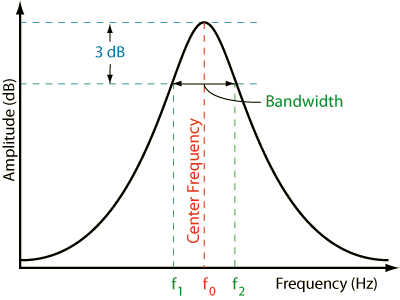Analog and digital audio designers confront daily every imaginable aspect of active and passive filters. Most often, these are bandpass filters partially characterized by a quality factor, Q, and a bandwidth, BW. There exists enough books on active and passive filter design to fill a modest office library, however, there are certain aspects of the relationship between bandwidth as expressed in octaves versus Q that are poorly documented — if at all.
The purpose of this article is to derive the mathematical relationships between these two variables and provide a useful “look-up” table for each, as well as a handy Excel™ spreadsheet program, which may be downloaded at the bottom of this page.
A bandpass filter is characterized by three major parameters: center frequency, amplitude response (gain), and bandwidth. Center frequency is the frequency at which the amplitude is maximum; gain is the maximum amplitude response occurring at the center frequency; and bandwidth (or passband) is the frequency range between the -3 dB points located on either side of the center frequency. Bandwidth is expressed in several ways: in frequency, as being so many Hertz wide; or in octaves, as being so many octaves (or fractional octave) wide; or in decades, as being so many decades (or fractional decade) wide. Far and away, the most common audio usage is to express bandwidth in octaves. It is here that the literature falls short in giving sufficient mathematical relationships to allow answers to be expressed easily in “octaves.”
When first designing an audio filter, normally the required BW in octaves is known and the associated Q needs to be calculated; once the filter has been designed than Q is easily calculated by measuring the -3 dB frequency points, taking the difference, and dividing that into the center frequency; and lastly, the BW in octaves is then calculated.
A third situation arises where only Q is known and the BW in octaves is desired. This calculation is not obvious — nor easy. The next section presents the necessary closed solutions for each of these calculations. For reference purposes, Figure 1 shows a bandpass filter with its associated parameters labeled for clarity and is used for derivation purposes.

If the -3 dB points are known, then calculating the BW in octaves is straightforward:
Let
,
where y is any positive real number.
Define N as the number of octaves of BW, i.e.,
N octaves means that
,
then
(1)
Solving for N gives
(2)
and, by definition
(3)
If the BW in octaves is known without knowledge of the actual -3 dB frequencies, and Q is to be calculated, then the following development leads to the required formula:
In general, f0 is the geometric mean of the skirt frequencies, f1 and f2:
therefore
.
From (1)
or
.
From (3) and (1)
or
(4)
Table 1 shows several examples of equation (4) for BW’s commonly used in audio design work.
BW (octaves) |
Q |
2.0 |
0.667 |
1.0 |
1.414 |
2/3 |
2.145 |
1/2 |
2.871 |
1/3 |
4.318 |
1/6 |
8.651 |
1/10 |
14.424 |
1/30 |
43.280 |
If only Q is known and the BW in octaves is desired then equation (4) must be turned around and re-expressed in terms of Q:
From (4)
or
.
Since
,
then
squaring gives
rearranging
applying quadratic solution:
(5)
N (the number of octaves of BW) is now found from equation (2). [See note 3 for a simpler form.]
2The squaring operation introduces an extraneous root appearing as the “minus” square root term. The “plus” square root term gives the correct answer. The “minus” square root term gives the reciprocal answer, i.e., the “plus” answer leads to y, while the “minus” answer yields 1/y.
3A simpler formula for determining the BW in octaves, given Q, appears here in RaneNote 167 Why DSP Boxes Set the Same Way Differ by Ray Miller. The simpler formula does not introduce the +/- ambiguity. [Thanks to Robert Bristow-Johnson for pointing this out.].
Table 2 gives a handy look-up reference of BW (octaves) versus Q.
Q |
BW (oct) |
Q |
BW (oct) |
Q |
BW (oct) |
0.50 |
2.54 |
1.50 |
.945 |
6.50 |
.222 |
0.55 |
2.35 |
1.60 |
.888 |
7.00 |
.206 |
0.60 |
2.19 |
1.70 |
.837 |
7.50 |
.192 |
0.65 |
2.04 |
1.80 |
.792 |
8.00 |
.180 |
0.667 |
2.00 |
1.90 |
.751 |
8.50 |
.170 |
0.70 |
1.92 |
2.00 |
.714 |
8.65 |
.167 |
0.75 |
1.80 |
2.15 |
.667 |
9.00 |
.160 |
0.80 |
1.70 |
2.50 |
.573 |
9.50 |
.152 |
0.85 |
1.61 |
2.87 |
.500 |
10.0 |
.144 |
0.90 |
1.53 |
3.00 |
.479 |
15.0 |
.096 |
0.95 |
1.46 |
3.50 |
.411 |
20.0 |
.072 |
1.00 |
1.39 |
4.00 |
.360 |
25.0 |
.058 |
1.10 |
1.27 |
4.32 |
.333 |
30.0 |
.048 |
1.20 |
1.17 |
4.50 |
.320 |
35.0 |
.041 |
1.30 |
1.08 |
5.00 |
.288 |
40.0 |
.036 |
1.40 |
1.01 |
5.50 |
.262 |
45.0 |
.032 |
1.414 |
1.00 |
6.00 |
.240 |
50.0 |
.029 |
![]() Bandwidth vs. Q Calculator (zipped) for Microsoft Excel.
Bandwidth vs. Q Calculator (zipped) for Microsoft Excel.
![]() "Bandwidth in Octaves Versus Q in Bandpass Filters" Download this note as PDF.
"Bandwidth in Octaves Versus Q in Bandpass Filters" Download this note as PDF.